Learn about the different types of drill bits so you can choose the right ones for your project and for the material you’re drilling.
Types of Drill Bits: Materials and Finishes
The materials from which bits are manufactured and the finishes applied to them play a significant role in the life and performance of the bit. Common materials and finishes:
- High-Speed Steel (HSS) drill bits can drill wood, fiberglass, PVC (polyvinyl chloride) and soft metals such as aluminum.
- Cobalt drill bits are extremely hard and dissipate heat quickly. They’re mostly used for boring in aluminum and tough metals such as stainless steel.
- Black oxide-coated HSS drill bits have a finish designed to help resist corrosion and increase durability. They last longer than basic HSS bits and work well on a variety of materials, including metal, hardwood, softwood, PVC and fiberglass.
- Titanium-coated HSS drill bits produce less friction. They’re tougher than basic HSS bits and stay sharp longer. They work for drilling wood, metal, fiberglass and PVC.
- Carbide-tipped drill bitsstay sharp much longer than steel, HSS or titanium bits. They’re effective for drilling tile and masonry.
Drill Bit Construction
For a typical drill bit, the angle of the point helps determine what type of material the bit can drill. Flatter points — such as those with 135-degree angles — are suited for drilling into harder material. They may require a pilot hole to keep the bit from wandering. Bits with steeper points — such as those with 118-degree angles — are suited for softer material. They stay on center better and produce cleaner entry and exit holes. Bits with split-point tips improve drilling accuracy by keeping the bit from wandering when you begin to drill.
Bit size reflects the diameter of the body. Some projects call for specific drill bit sizes, but a bit set that includes sizes from 1/16-inch to 1/4-inch will handle many jobs around the home and workshop. You can add larger bits – 5/16-inch, 3/8-inch, 7/16-inch and 1/2-inch bits if you need them.
The chuck on a hand drill or drill press secures a drill bit to the tool along the bit’s shank. A smaller drill for work around the house typically has a 3/8-inch chuck. More powerful drills for heavier applications have a larger, 1/2-inch chuck. Drill presses also have larger chucks — 1/2-inch or 5/8-inch, for example. The bit shank size must not exceed the chuck size of the drill. A larger bit may have a reduced shank — a shank with a smaller diameter than the body of the bit — allowing you to use it with smaller chucks.
- A round shank allows you accurately center a bit in the chuck.
- A hex shank has flat surfaces, allowing the tool to grip the bit more securely for greater torque. Hex shanks such as the one in the image above work with quick-change chucks — common on cordless drills — allowing you to insert and remove them without tightening and loosening the chuck.
- An SDS (slotted drive system) shank is designed for use on a hammer drill; it fits a spring-loaded chuck that doesn’t require tightening. The bit can move forward and backward with the hammering motion of the drill while flattened areas and slots on the shank allow the chuck to hold the bit.
Twist Drill Bit – A twist bit is the most common type of drill bit for home use. It works for general-purpose drilling in wood, plastic and light metal.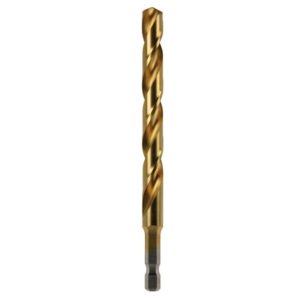
Brad-Point Drill Bit – A brad-point bit is designed for boring into wood. The brad at the center of the bit tip helps position the bit precisely for accurate drilling and produces a clean exit point in the work piece. The flutes — grooves that wrap around the bit and channel away chips and dust — are extra-wide to remove more material.Auger Drill Bit – An auger bit, another type of wood-boring bit, has a screw tip that starts the hole and pulls the bit through the work piece. These bits can be as long as 18 inches. As with the brad-point bit, large flutes help remove chips and dust. An auger bit with a hollow center provides even more chip removal, one with a solid center is stronger and more rigid.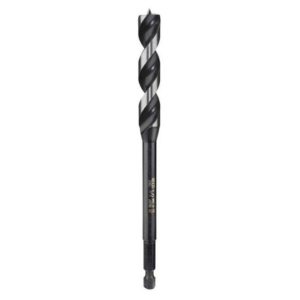 Self-Feed Drill Bit – A self-feed bit bores through wood. Like the auger bit, a screw at the tip helps position the bit and draws it through the work piece. However, this bit is more compact. It doesn’t have the standard flutes of a twist bit, so you need to pull the bit back periodically to clear away chips and dust.
Self-Feed Drill Bit – A self-feed bit bores through wood. Like the auger bit, a screw at the tip helps position the bit and draws it through the work piece. However, this bit is more compact. It doesn’t have the standard flutes of a twist bit, so you need to pull the bit back periodically to clear away chips and dust.
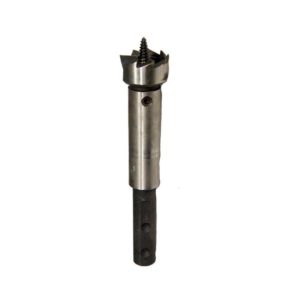 Installer Drill Bit – An installer bit is a specialized twist bit designed for installing wiring. The bit can be up to 18 inches long and drills through wood, plaster and some masonry.
Installer Drill Bit – An installer bit is a specialized twist bit designed for installing wiring. The bit can be up to 18 inches long and drills through wood, plaster and some masonry.
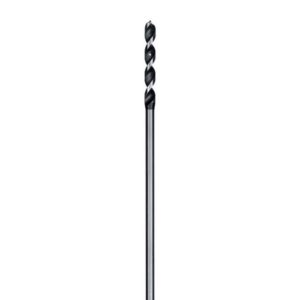
Once you drill through the wall, floor or other surface, you insert a wire into the small hole in the bit and use the bit to draw it back through the hole you bored.
Spade Bit – A spade bit, also known as a paddle bit, bores large-diameter holes — up to 1-1/2 inches in diameter — in wood. It has a flattened blade with a sharp point that helps position and steady the bit. Some spade bits have points at the two edges that help create a neater hole and exit point.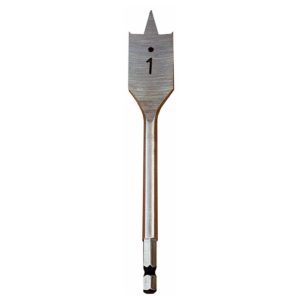
Forstner Drill Bit – A Forstner bit bores smooth, clean holes in wood. You can use it to create flat-bottomed holes — such as for receiving dowels. The design also allows you to overlap holes. A point helps you to position the bit precisely on the workpiece. Pull the bit out regularly to clear away chips and dust as you work. A hand-held drill may not always give you the force or control you need to use a Forstner bit, so a drill press is a better option for some applications.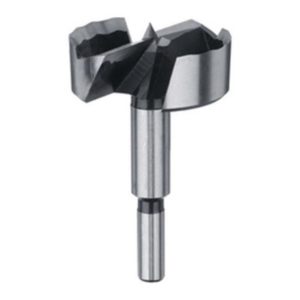
Hole Saw – A hole saw drills large holes — such as for installing door hardware or creating a pass-through for wiring. A hole saw creates a plug of waste material; a cut-out in the side of the saw cylinder allows you to push it out. Typically, a hole saw attaches to an arbor or mandrel which includes a shank. The arbor also holds a pilot bit for centering and steadying the cutting blade. Some smaller hole saws have a built-in shank and don’t use a pilot bit.
A bi-metal hole saw cuts through wood and metal. A hole saw with a carbide edge works on heavier materials such as ceramic tile and masonry. A hole saw with a diamond edge also works on tile and masonry, but cuts faster than carbide models.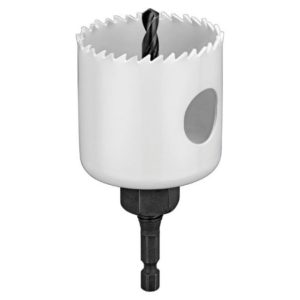
Countersink Drill Bit – A countersink bit — also called a screw pilot bit — is a specialty bit for drilling in wood. In a single action, the bit can drill pilot, counter sink and counter bore holes, allowing you to countersink a fastener and install a plug over the fastener head.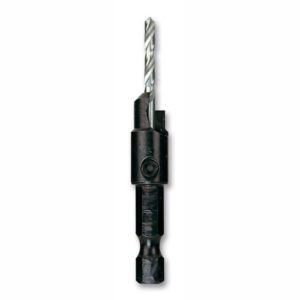
Plug Cutter – A plug cutter bores holes in wood, creating wood plugs for use in concealing recessed fasteners.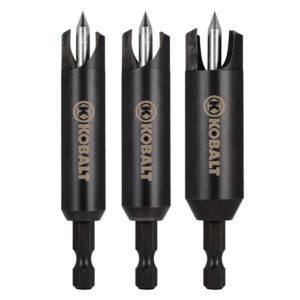
Step Drill Bit – A step bit is designed primarily for drilling in thin — up to 1/4 inch — metal, but will work with wood. The stepped design allows you to use a single bit to drill holes with different diameters. Often the diameter of each step is etched into the bit. You can also use this type of bit to deburr holes, clearing away waste material.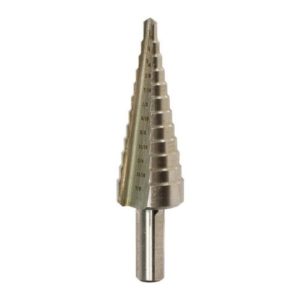
Tile Drill Bit – A tile bit uses a carbide tip to drill into some types of tile while reducing the chance of chips and cracks. Check the packaging to determine the tile it can drill.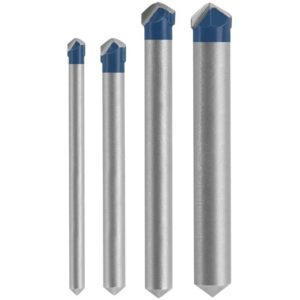
Masonry Drill Bit – A masonry bit drills into tough materials such as concrete, brick and other masonry. Some work with a standard corded or cordless rotary drill, but those designed for use with a rotary hammer or hammer drill can bore into masonry more effectively. The hammering action of the tool drives the carbide tip into the material while the rotating action channels away debris along the flutes.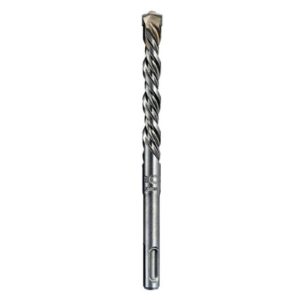
Other Bit Options – In addition to more common drill bits, there are other options and accessories:
- Drill saw bits cut irregular holes and contours in wood and metal.
- Pocket hole bits are included with pocket hole jigs. They allow you drill angled holes that accept screws for making wood joints.
- Scaling chisels work in rotary hammers or hammer drills for chiseling, scaling and chipping masonry.
- Depth stops prevent drilling beyond a predetermined depth.
- Driver bits and bit holders work on a drill / driver to install or remove fasteners.
- Drill bit extensions give your drill a longer reach.
- Screw or bolt extractors work with a reversible drill / driver to back out damaged fasteners.
- Right-angle attachments let you drill and drive in areas where a drill won’t fit.
- Drill / driver bit sets collect various sizes and styles of bits in a convenient case.

Leave a Reply to Perry Nuhn Cancel reply